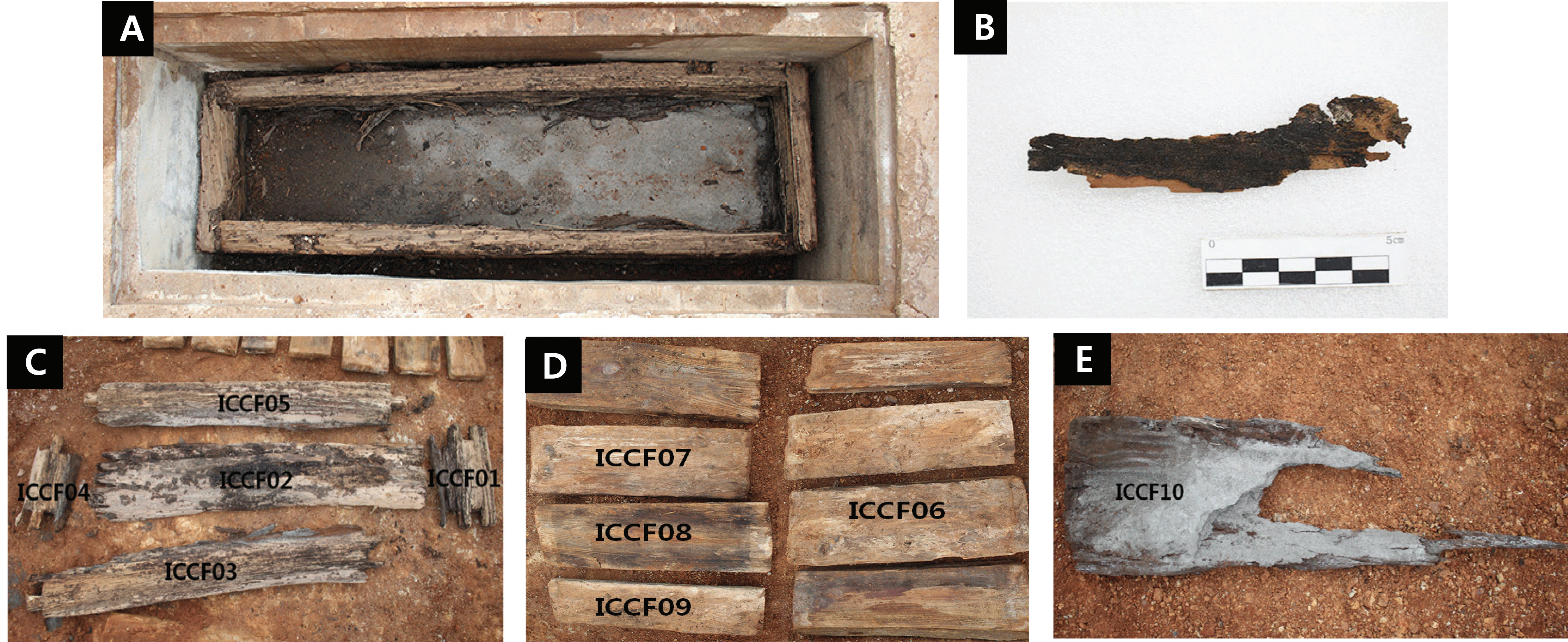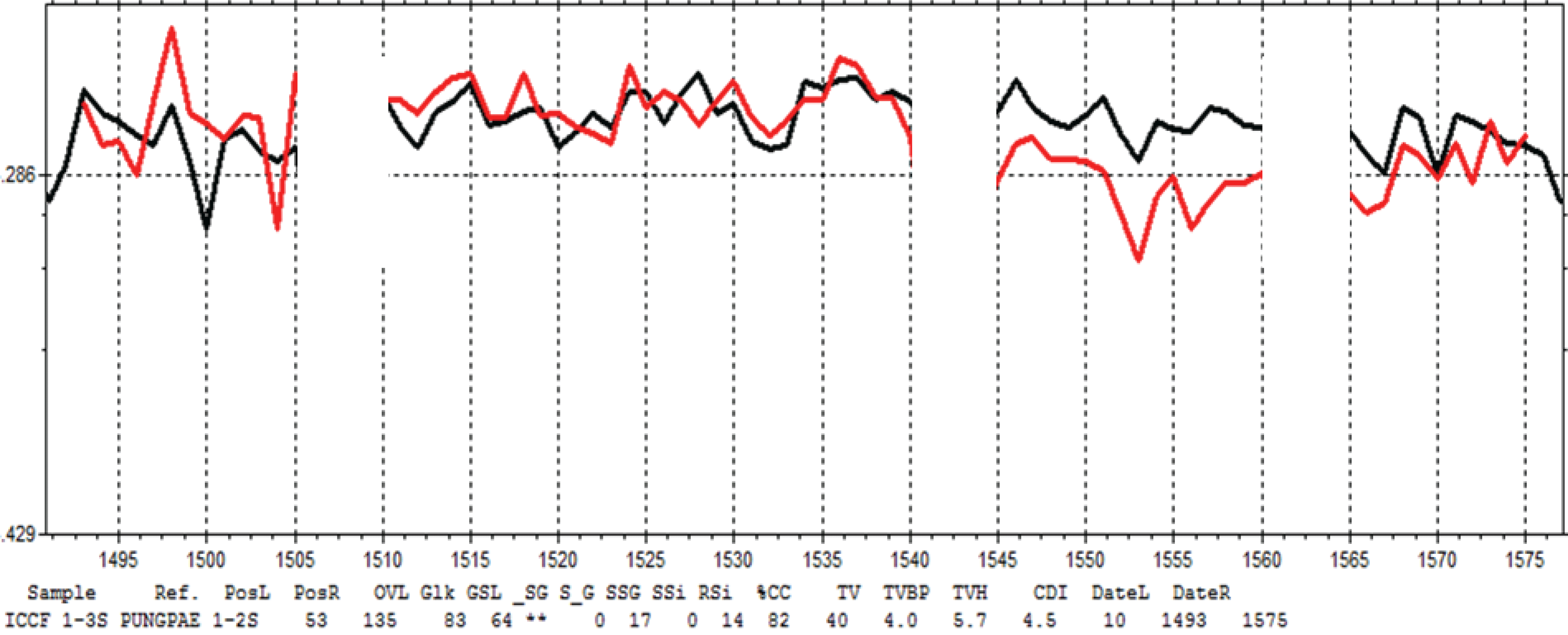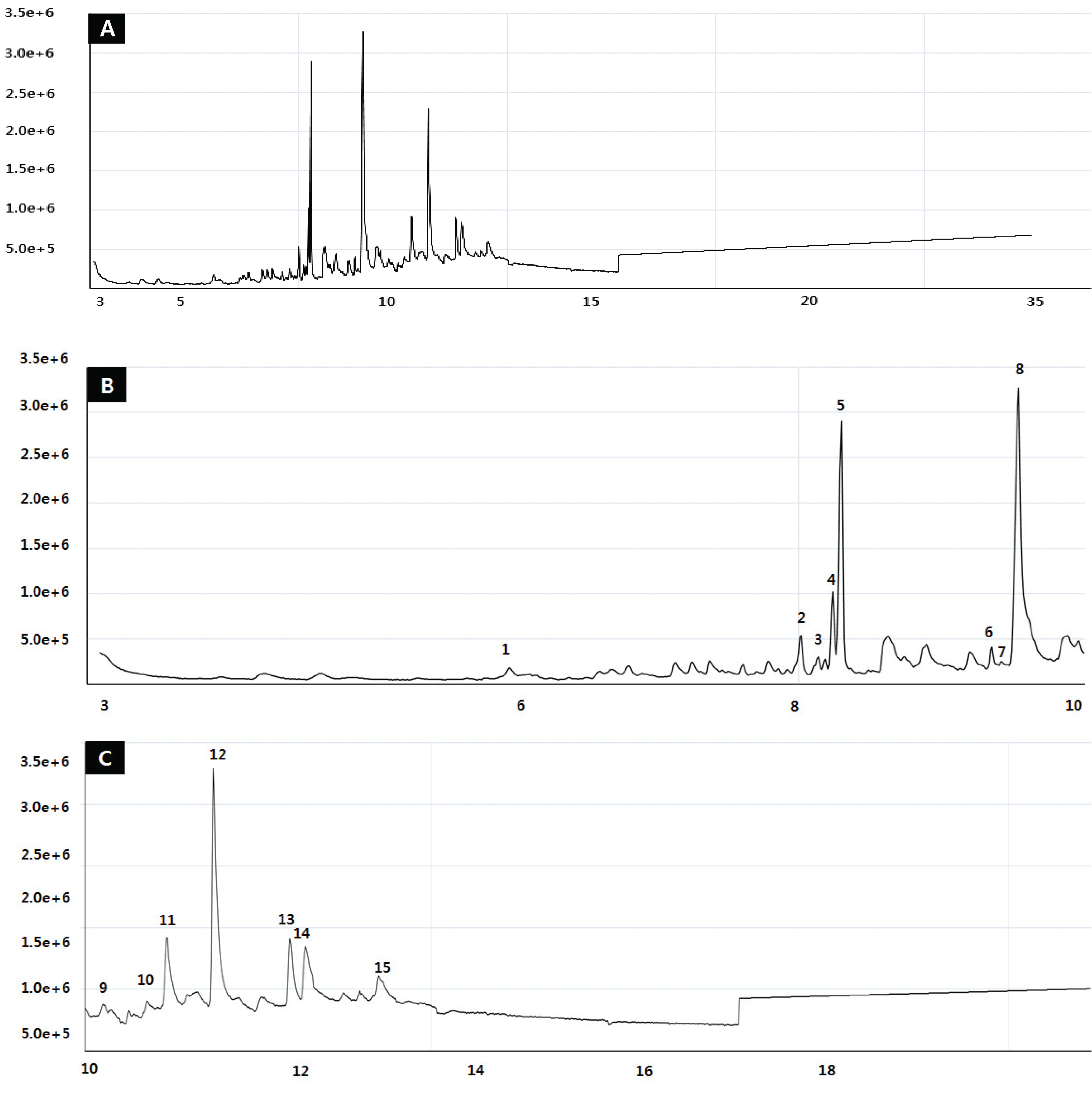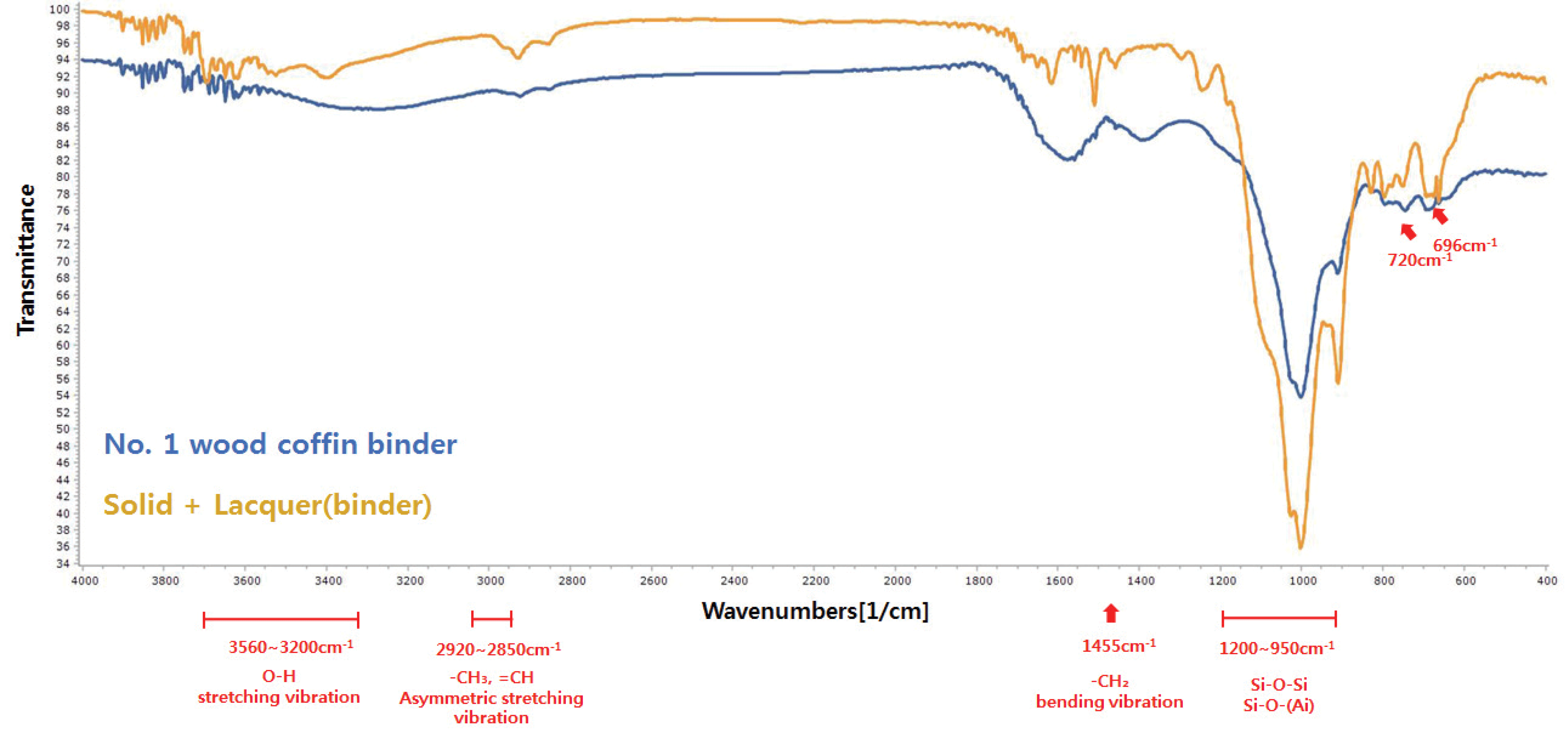1. INTRODUCTION
Trees’ growth varies under the influence of the surrounding environment (temperature, humidity, soil, nutrition, etc.), thereby creating annual rings of various widths (Stokes and Smiley, 1968; Baillie, 1982). Among the various elements of the annual ring, ring width is not only easy to measure but also stores various environmental information. Thus, it is the most commonly used factor in dendrochronology (Seo, et al., 2017). Therefore, annual ring dating is based on the method of measuring the age by using annual ring width. In order to apply the ring dating method, a standard annual ring pattern is required, and since the annual ring pattern varies across regions and tree species, it is necessary to establish a standard annual ring chronology for different species in various regions (Lee et al., 2018). Pine, which occupies the majority of Korean forests, was the most preferred building material in Korea (Park and Lee, 2007). Currently, the standard annual ring pattern of pine trees has been recorded until the end of the Goryeo Dynasty. This standard pattern has been used to date not only a number of wooden structures and traditional wooden relics but also the relics excavated from various archaeological sites. In particular, there are many wooden coffins made of pine unearthed among the relics, but there are cases where it is difficult to identify the burial period of wooden coffins because buried objects have not been identified. Therefore, studies are being conducted to identify the burial period through the tree-ring dating of the wooden coffin itself. The felling year was estimated in the six wooden coffins excavated at the ruins of Naeheung-dong, Gunsan, suggesting that they were buried approximately in the 16th century (Park and Lee, 2009). Regarding the ten coffin materials found at the ruins of Sinnae-dong, Seoul, the presence of the analysis of line-soil mixture barrier determined that the lime-soil mixture barrier tombs were dated between the 16th and 17th centuries (Lee, 2009). As for the two common graves excavated from the Hopyeong Ruins in Namyangju, the burial period was roughly estimated through tree-ring dating (Park et al., 2006a). In addition, it was confirmed that the internal and external wooden materials excavated at the Jeonju Majeon site were felled around the same time (Park et al., 2006b). There are some dendrochronological studies on wooden coffins, but there are few studies on the other materials used for wooden coffins.
The site of Sipjeong-dong, Incheon, which is the subject of this study, is located in the area of 201-28 Sipjeong-dong, Bupyeong-gu, Incheon. As a result of specimen analysis and excavation, two lime-soil mixture barrier tombs were found around a slope of a hill in the northern and southeastern survey boundary of the tomb, and around the northern survey boundary of the flatland. In addition, three lime-soil mixture barrier tombs were found on the southeastern hilly slopes and flatlands. Wooden coffin materials were identified in No. 1 of the total five tombs, but no relics were able to be dated, and a material presumed to be fiber was attached to the wooden coffin, and a coating presumed to be lacquer was painted on the surface.
Therefore, in this study, tree-ring dating was conducted to confirm the burial period for the No. 1 tomb excavated in Sipjeong-dong, Incheon. In addition, a scientific analysis was performed on the fibers attached to the wooden coffin and the paint on the surface to identify the materials used in the manufacture of the wooden coffin.
2. MATERIALS and METHODS
The subject of analysis is the 1st lime-soil mixture barrier tomb excavated in the ruins of Sipjeong-dong, Incheon. For the wooden coffin of No. 1 lime-soil mixture barrier tomb, a total of 14 materials were identified, including 5 materials (head panel, leg panel, right panel, left panel, and bottom panel), 8 cross short-planks, and outer bottom panel. Among these materials, 10 materials with more than 30 rings were selected. In addition, the paint that was left on the left side of the wooden coffin and the fibers that were attached to the surface of the wooden coffin were collected (Fig. 1, Table 1).

For tree species analysis, specimens from 10 pieces of the wooden coffin materials were collected. A razor blade was used to make a three-section flake of about 20μm thickness, a preparat was manufactured for analysis of the species, and then the tissue was observed with an optical microscope (ECLIPSE LV100, Nikon, Japan) to find features that could identify the species, which were photographed.
In the ring dating, the selected material was observed to see if there is a bark. The bark or a part close to the bark was sampled using a chain saw. The collected disk was polished with sandpaper so that the annual rings could be clearly visible. The annual ring of each specimen was measured with an accuracy of 0.01 mm using an annual ring width meter (LINTAB) attached to a computer. When the annual ring width is measured, if decay, missing ring, false ring, or discontinuous ring occurs, it is impossible to give an accurate growth year to the observed annual ring, making it difficult to conduct an accurate dating (Oh et al., 2017). Therefore, the annual ring width was measured two or more times according to the direction of each material, and missing and false ring were checked. The created annual ring width graph was cross-dated (relative solidarity) (Cross-dating is to search and compare the annual ring patterns of the wood with the same age and region, identify missing and false ring, and compare them with the known reference age (the felling year of the current tree) to give the exact age of growth to each annual ring). For cross-dating, TSAP-Win program (RINNTECH, Germany) was used, and graph comparison method (graphic method) and statistical comparison method (t value using correlation coefficient, G value using sign test (gleichläufigkeit)) were used. When comparing the chronology of more than 100 years, the criterion for a significant result is a t value of 3.5 or more and a G value of 65% or more (Park et al., 2003).
Microscopic observation and FT-IR were performed to check the fibers attached to the left side plate of the wooden coffin No. 1. For microscopic observation, the fibers were immersed in distilled water for 1 week, washed, and then dissociated to prepare a preparat for surface observation. After fixing the sample in the vertical direction using an epoxy resin (Epofix), it was cut into 10-15 μm-thick slices to prepare a preparat for cross-sectional observation. The prepared specimen was observed at low to high magnification using an optical microscope, and its characteristics were photographed.
For FT-IR analysis, equipment (Cary620 Microscope, Agilent, USA) was used in ATR mode. Analysis conditions were 4 cm-1 in resolution, 400 to 4000 cm-1 in range, and 32 in the number of scans, and the analysis was repeated 3 times for each specimen. The results were measured by comparing with a material having an IR peak value similar to that of the Agilent Library or the House Library constructed by the Institute of Wooden Cultural Heritage of Korea Traditional Culture University.
In order to check the paint collected from the left panel of the wooden coffin No. 1, FT-IR and pyrolysis- gas chromatography/mass spectrometry (Py-GC/ MS) were conducted. For FT-IR analysis, an instrument (Cary620 Microscope, Agilent, USA) was used in ATR mode. Analysis conditions were 4 cm-1 in resolution, 400 to 4000 cm-1 in range, and 32 in the number of scans, and the analysis was repeated 3 times for each specimen. The results were measured by comparing with a material having an IR peak value similar to that of the Agilent Library or the House Library constructed by the Institute of Wooden Cultural Heritage of Korea Traditional Culture University.
Py-GC/MS was carried out by attaching a pyrolysis device (PY-3030D, Frontier Lab, Japan) to the inlet of the GC. The weight of the analysis specimen was 0.30 mg, and the thermal decomposition temperature was 500°C. For columns, DB-5MS (5%-Phynyl-methyl polysiloxane, 30 m × 250 μm × 0.25 μm) was used. Split mode (30:1) was used as the injection mode. He (99.999%) was used as the carrier gas, and the flow rate was 1 ml/min. The oven temperature was initially maintained at 40°C for 5 minutes, and then the temperature was increased to 300°C at a rate of 20°C /min, and the final temperature was maintained at 300°C for 10 minutes. The mass spectrometer conditions were 40 to 800 in the mass range (m/z), the MS conversion temperature was 280°C, the MS ion source temperature was 230°C, and the MS material temperature was 150°C.
3. RESULTS and DISCUSSION
All 10 wood coffin materials excavated from Sipjeongdong, Incheon, were identified as pines that belong to Pinaceae and pine genus (Fig. 2). Since all 10 materials were pine trees, micrographs of the outer base plate (ICCF 10) were representatively inserted. In the cross section, the transition between early and late woods was rapid, and longitudinal resin cannels were distributed (Fig. 2A). In the radial section, the arrangement of the bordered pit in the axial directional tracheid was mostly one row, and the ray tissue consisted of the ray tracheid and ray parenchyma cells, and the cross- field pitting was window-shaped and the ray tracheid was dentate thickening (Fig. 2B). In the tangential section, fusiform rays including uniseriate and radial intercellular canals were observed (Fig. 2C). Among pine trees, thickening was observed in the ray tracheid. This species was identified as subgenus pine, that is, subgenus pine (soft pine), as it is distinguished from subgenus cypress, which is characterized by rapid transition of early and late woods.

After completing the individual annual chronology for 10 materials, 5 individual ring chronologies, including the head panel (ICCF 01), right panel (ICCF 03), leg panel(ICCF 04),cross short-planks 1 (ICCF 06) and cross short-planks 3 (ICCF 8) that were successfully cross-dated, were used to prepare a representative ring chronology of the coffin materials excavated in Sipjeongdong, Incheon, for a total of 83 years. As a result of comparing and analyzing the prepared annual chronology with the standard chronology held by the institute, the t-value of 5.7 and the G-value of 64% did not exceed the criterion of the standard G-value of 65%. However, a significant degree of agreement was confirmed in the graph comparison, which led to the conclusion that the representative ring chronology prepared in five materials was successful in cross-dating. Therefore, the representative annual chronology was given the absolute year 1493-1575 (Fig. 3). The other five wood coffin materials could not be compared and analyzed because the annual rings were very short (less than 50).

As a result of microscopic observation of the fibers attached to the left panel of the wooden coffin materials excavated in Sipjeong-dong, Incheon, the surface was smooth and a stripe shape was observed in the length direction of the fiber (Fig. 4A), and the cross section was observed in an irregular triangular shape with a smooth shape (Fig. 4B).

As a result of FT-IR analysis, the absorption spectrum was found at 3300 cm-1 (N-H stretching vibration), and a strong absorption spectrum peak was found at 1628 cm-1 in the 1700~1600 cm-1 (amide I) region. In addition, absorption spectrum peaks at 1528 cm-1 were successively found in the 1530 cm-1 (amide II) band. According to Baek and Cho (2012), it seems to be a component of fibroin that constitute silk fibers. In addition, as a result of comparison with the control spectrum, there was a similarity in the spectrum between the control and the fibers attached to the left plate of the wooden coffin materials excavated from the Sipjeong-dong site in Incheon (Fig. 4C).
FT-IR analysis of the paint identified on the left panel, a broad spectrum of the bands, 3560-3200 cm-1 by O-H stretching vibration (hydroxyl group), and 1200~950 cm-1 by antisymmetric Si-O-Si, Si-O-(Ai), was observed, and a fine absorption spectrum peak at 780 cm-1 was observed. In addition, the absorption spectrum was found at 2920 ~ 2850 cm-1 caused by asymmetric symmetric stretching vibration (methylene group) of -CH3 and =CH. In the fingerprint region of 1,500 cm-1 or less, fine absorption spectrum peaks were observed at 1455 cm-1 (bending vibration of methylene groups), 720 cm-1, and 696 cm-1 (Fig. 5). According to Cho (2010), Choi & Kim (2018), Park et al. (2017), and Kim (2007), branch spectra are observed; Urushiol polymer, the main component of lacquer, with an absorption spectrum of 3560~3200 cm-1 due to O-H stretching vibration (hydroxyl group), the absorption spectrum of 2920-2850 cm-1 due to the asymmetric symmetric stretching vibration of -CH3, =CH2 (methylene group), C=C, C=O absorption spectrum of 1730~1600 cm-1 by the double bond, the absorption spectrum of 1455 cm-1 due to methylene group bending vibration and other absorption spectra of 991 cm-1 (conjugated triene), 860 cm-1 (a blood polymer with 1,2,3,5-substituted benzene structure), and 720 cm-1 (1, 2, and 1, a characteristic of Urushiol polymer Absorption spectrum from 3-trisubstituted benzene). As a result of performing additional analysis on the control group prepared by mixing mineral and lacquer, the control (mineral + lacquer) and the coating identified on the left plate showed similar spectra (Fig. 5).
In Pyrolysis-GC/MS analysis, Camphene (No. 1), Cumol (No. 3), O-Cymene (No. 4), Sabinene (No. 5), Indene (No. 9), and (+)-Longifolen (No. 15), etc., were analyzed (Table 2, Fig. 6). The resin extracted from wood contains the majority of essential oils and resins, and contains Myrcene, Terphenyl, Pinen, and Longifolen. In particular, in the case of pine resin extracted from pine trees, it also contains camphene, Phellandrene, and terpenalkohol, which is the same material as found in Shin and Kim (2005) and Park (2019). Also, Phenol, 2-methyl (No. 6), Phenol, 3-methyl (No. 7) and 1,2- Benzenediol, 3-methyl (No. 10), 1,2-Benzenediol, 4-methyl (No. 11), and 1 -tetradecane (#13) was observed. According to Choi and Kim (2018) and Park and Ahn (2018), Phenol, 2-methyl, Phenol, 3-methyl of m/z 108 and 1,2-Benzenediol, 3-methyl of m/z 123, 1,2-Benzenediol, and 4-methyl are characteristics that appear when catechol derivatives are pyrolyzed. In addition, in previous studies, 1-tetradecane was used as a characteristic of Asian lacquer tree (Rhus vernicifera). Therefore, it seems that the ingredient of lacquer identified on the left panel was lacquer collected from Rhus vernicifera.

As a result of tree species analysis of 10 materials collected from the No. 1 wooden coffin excavated from the site of Sipjeong-dong, Incheon, all were identified as pines that belong to Pinaceae and pine genus. Pine trees in Korea include pines, black pine (Pinus thunbergii), and junggomsol (Pinus densi-thunbergii Uyeki), but these species are not anatomically distinguishable. In addition, since the Incheon area is close to the coast, black pine might have been used in the wooden coffin, but because the ring pattern was consistent with the standard chronology of pine trees in Korea, the materials are considered as pines (Pinus densiflora S. et Z.). The pine species grow straight in all areas of Korea except northern highlands and is moderately weatherproof and suitable for use in coffins (Park and Lee, 2007). Therefore, woods used in the wooden coffin of No. 1 excavated from the ruins of Sipjeongdong, Incheon, are easily available from the surrounding areas, and pine trees seem to have been favored in making coffins for their straight characteristics.
In tree-ring dating, a total of 5 materials were matched, and the outermost ring corresponded to the year 1575. If bark existed among the materials, the exact year of felling and burial could be determined. However, no bark was present in any of the materials. For that reason, in this study, it was estimated that wooden coffin No. 1 was buried after 1575 or after the late 16th century.
The fibers attached to the No. 1 wooden coffin materials turned out to be fibroin through microscopic observation and FT-IR analysis. Examples of fibroin used in the wooden coffin are included in the book “Chosun Dynasty Gukjang Dogameugwe”. According to the book, “the inside of the wall is covered with red silk and squares with green silk”. Lee (2009) confirmed that the fabric attached to a total of five wooden coffins dated as the 1500s to the 1700s was silk fiber in “A study on ring dating, ornamentation, and manufacturing of wooden coffins in the Joseon Dynasty.” Infrared spectroscopy of the paint on the wooden coffin showed the following: OH stretching vibration, characteristic of Urushiol polymer (3560~3200 cm-1 band absorption spectrum), -CH3, =CH2 (methylene group) asymmetric symmetric stretching vibration (2920~2850cm-1 band absorption spectrum), C=C, C=O double bond (absorption spectrum of 1730 to 1600 cm-1 band), bending vibration of a methylene group (absorption spectrum of 1455 cm-1), conjugated triene (absorption spectrum of 991 cm-1), and a blood polymer (absorption spectrum of 860 cm-1) having a 1,2,3,5-substituted benzene structure. The absorption spectrum was observed in 1,2,3-Trisubstituted benzene (absorption spectrum of 720 cm-1), which is a characteristic of Urushiol polymer. As a result of pyrolysis- GC/MS analysis, pyrolysis characteristics of catechol derivatives and 1-tetradecane, a characteristic of Rhus vernicifera, were observed. According to Cho (2010), Choi & Kim(2018), Kim (2007), and Park & Ahn(2018), this is the main component of lacquer, and the coating of wooden coffin excavated in Sipjeongdong, Incheon No. 1 was lacquered. However, as a result of pyrolysis-GC/MS analysis, Camphene, Cumol, O-Cymene, Sabinen, Indene, (+)-Longifolen, etc. were analyzed. According to Shin and Kim (2005) and Park (2019), the characteristic is a component of pine resin extracted from pine wood. Therefore, considering that the wooden coffin materials excavated in Sipjeongdong, Incheon No. 1 used pine trees, pyrolysis-GC/MS analysis showed that pine resin was additionally used in the coffin. Examples of lacquer coatings on wooden coffins include wooden coffin materials from the tomb of King Muryeong in Baekje, Dongha Tomb in Neungsan-ri, Baekje, Neungsan-ri tomb, and from Nongso tomb in Unrim-ri, Sunchang (Buyeo National Museum Special Exhibition, 2019; Kim et al., 2010; Lee, 2017). This can be confirmed in the “Kukjo Oryeui” built in the King Sejong days during the Joseon Dynasty and in the “Extended Handbook of Cases” published by Ji Song-wook in 1900. According to the contents of the wooden coffin of “Kukjo Oryeui”, “the king's coffin is made of pine trees in the year of the king's enthronement in Gongjo and lacquered once a year”. According to “Extended Handbook of Cases”, pinewood powder (pine charcoal powder) was applied on lacquer and pine resin on the interior and exterior surfaces of the wooden coffin (Kim, 1996; Lee, 2009). In addition, according to the records of the old literature, such as the Forest Economy, Gyuhap Series, and Oju Seojong Bakmulgobyeon, there are cases where the lacquer was used as an adhesive for broken earthenware, porcelain, and tiles (Yang and Moon, 2005). Given these results, it seems that the wooden coffin No.1 excavated from the ruins of Sipjeong-dong, Incheon, was made of pines that were felled after 1575, and fibroin was applied to its surfaces which were painted with lacquer.
4. CONCLUSION
The outermost ring was dated the year 1575 through the ring dating analysis of 10 materials collected from the No. 1 wooden coffin excavated from the ruins of Sipjeong-dong, Incheon. However, the burial period of the wooden coffin materials couldn’t be estimated because the bark was not present; it could only be assumed that it was buried using the wood felled after 1675. As a result of the tree species identification of the coffin materials, it was identified anatomically only as pine, but since the ring pattern was consistent with the standard chronology of pine trees in Korea, it is highly likely to be pine (Pinus densiflora S. et Z.). This wood can be easily obtained from the surrounding areas and has the characteristic of growing straight. Thus, it seems that pine was used in the manufacture of the coffin. In addition, the analysis of the remaining fibers and coating on the left side plate showed that they were identified as fibroin and lacquer. Records such as “Chosun Dynasty Gukjangdogamuigwe”, “Kukjo Oryeui”, and “Extended Handbook of Cases” indicate that fibroin was attached to the wooden coffin or lacquer was painted before burial. Therefore, it could be concluded that the wooden coffin materials excavated from the ruins of Sipjeong-dong, Incheon, were made of pine buried in the Joseon Dynasty after 1575, and fibroin was attached to the exterior of the coffin painted with lacquer before burial.
If studies are conducted on the manufacturing techniques, materials, and styles of wooden coffins in the future, it seems possible to identify the pattern of how materials and styles were used in Korean wooden coffins according to different time periods. In addition, this can provide useful information for the preservation and restoration of wooden coffins.









